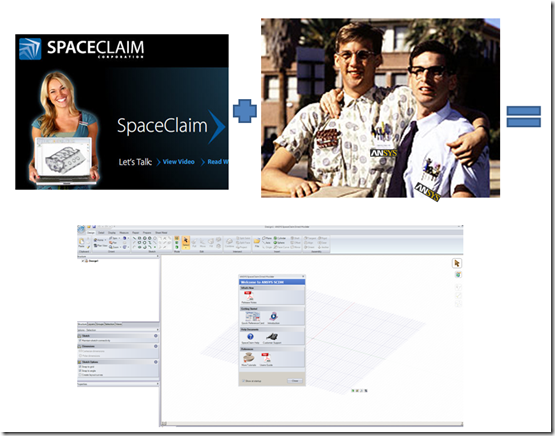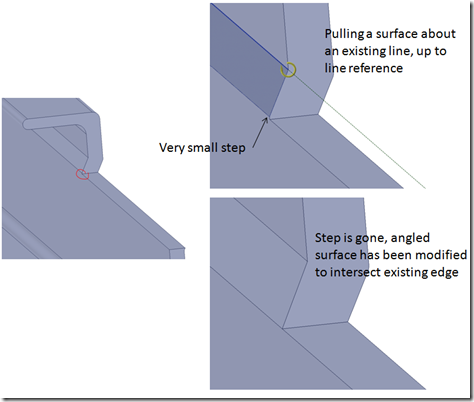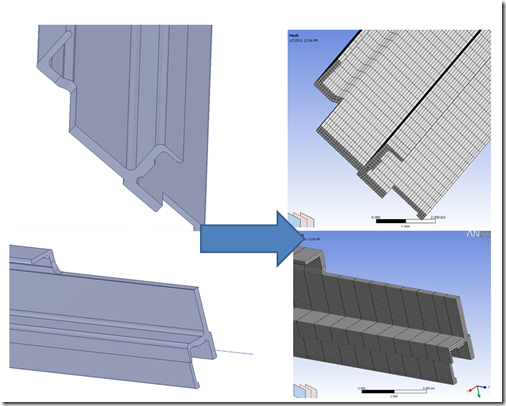Those keeping up with ANSYS, Inc. update presentations may have seen mention of a new product called ANSYS SpaceClaim Direct Modeler. ANSYS SpaceClaim Direct Modeler is a slightly modified version of the CAD package SpaceClaim (from the SpaceClaim Corporation). It is sold by ANSYS, Inc. and can operate either as a stand-alone application or integrated into the Workbench environment. It’s a nice combination of a slick CAD tool for use in a high-powered FEA program.
In case you’re keeping count, SpaceClaim brings the total number of geometry processing modules ANSYS offers up to 3:
The very first one is /prep7, available within ANSYS MAPDL. If you’re using this for serious CAD work, you have way too much time on your hands. It’s good at doing basic modifications (surface imprints, solid gluing, surface stitching) but not much else. The nice thing about it is that you can harness APDL to create batch jobs. I’ve seen this used heavily in board and package level semiconductor analyses for creating BGAs and all the other small parts that need to be considered.
The next module is DesignModeler. This is the default CAD creation/manipulation/repair module within ANSYS Workbench (requires additional license). DesignModeler (or DM as the cool kids call it) does everything except create detailed drawings. It’s extremely useful for creating fluid domains, gluing bodies for conformal meshes in Workbench, repairing/modifying geometry, and is overall an indispensable tool for creating efficient models within Workbench.
As I mentioned at the top, there is a new module called ANSYS SpaceClaim Direct Modeler (still waiting for confirmation that the cool kids call it SCDM, as the product is fairly new) which is an alternate CAD module within Workbench. So what’s the difference between DesignModeler and SpaceClaim? Glad you asked! Here’s a 30k-ft top-level view:
| DesignModeler | SpaceClaim |
| History-Based CAD Creation | Direct (Explicit) CAD Creation |
| Uses CAD Plug-Ins to Import Geometry | Uses CAD Translators to Import Geometry |
| Assembling Multiple Parts is ‘Character Building’ | Assembling Multiple Parts is Easy |
So let’s dig in to these differences.
History vs Direct CAD Creation:
Regardless of how you create geometry, underneath the hood there’s some fairly complicated math going on to build NURB surfaces. The overall shape of the geometry is defined by the order, control points, and knot vector in addition to all the continuity conditions that are enforced. Now that I’ve lost your attention, the difference between history and direct CAD modeling is in how all these controls are defined. A history-based modeler has (as you guessed) a history, typically in the form of a tree. This means you need to have some design intent in place to have downstream features created relative to existing objects. Long story short, this makes it easier to tweak designs while still maintaining the design intent as well as aide in any CNC machining operations (hopefully your history matches what would be performed by the machinist).
Direct modeling, on the other hand, doesn’t have a history. It just is. So unlike history-based modeling, you won’t run into an issue of deleting a fillet/chamfer and have downstream operations fail. You don’t have to worry about implied datums or anything else like that. Where the wheels fall off the direct modeling method are if you need to repeat a bunch of downstream operations. For example, I had just completed a major defeaturing effort on a sheet-metal riveted nightmare. The analysis showed that the current design was inadequate, so more rivets were added. Using SpaceClaim, I can’t just go back to an upstream import and redefine a few downstream operations. I wound up repeating the same defeaturing operations on the negative margin portion of the model, then slapped it into the existing model. Direct modeling really shines if you’re trying to tweak the shape of a part by just pulling/pushing certain faces together, if you were using a history-based modeler you would have to base all of your operations on existing objects, which can be extremely tedious and/or impossible. An example is shown below, where a tiny step is removed by drafting (through a ‘Pull’ operation) a face to an existing edge:
Long story short, history-based offers a good ‘turn the crank’ capabilities to recreate entire assemblies based off of a few minor tweaks. Direct modeling skips the hassle of accidental datums and other parent/child relationships. Direct modeling may feel like CAD without a safety net, I prefer to view it as more of a Buddhist-esque CAD system. Stop grasping after the history tree and you’ll find enlightenment (for most situations).
CAD Plug-ins vs Translators:
This one is simple. Plug-ins require the CAD system to be installed locally on the machine. Translators do not. Both SC and DM will import SolidWorks, Pro/E, and all your other favorite CAD systems. The difference is that if you’re using DM, you’ll need to have the source-CAD tool installed as well. If you’re using SC you can free up that disk space.
Creating Assemblies:
For anyone who’s ever used DM to assemble multiple parts together, I feel your pain. It essentially uses the same methodology of /prep7’s VTRAN command to translate a selected part from one coordinate system into another. Starting at R12, you could specify translations and rotations, but you still had to know how far to move the part to place it properly. Once you get the hang of it, it’s not hard (just tedious). Throw in the frozen vs active (aka unfrozen) behavior, and it can make for some choice words after hitting ‘Generate’
Oh, how I’ve wished that there was a way to specify a mate/align/insert constraint. In comes SpaceClaim, like a knight in shining armor (or like Will Ferrell as a lumberjack in Stepbrothers…I’ll let you look it up on youtube). Super easy to assign constraints and assemble your parts. Like most other operations in SC, it’s intuitive. Pick two cylindrical faces and hit ‘align’ and BAM, you’ve got a coaxial constraint. Pick to faces and hit ‘align’, KAPOW, you’ve got an align/mate constraint.
On top of these things, here’s a quick list of other features.
| Cross-Section Mode | Easy to create cross-section views
Changes made to cross-section view propagates through entire solid (awesomely awesome if you ask me) |
| Keyboard Shortcuts | Basic keyboard shortcuts for most common operations |
| Midsurfacing (DM) | Extract midsurface representation and thickness for use in shell meshing |
| Shared Topology (DM) | Ability to define multi-body parts for conformal mesh |
| Interference Detection | Find (and fix) overlapping regions in an assembly |
| Multiple Tabs | Ability to open a single part in its own tab. Changes made on separate tab propagate back to assembly |
(DM) represents existing features currently within DesignModeler
So, now that you’re tripping over yourself to get your hands on this new tool, where do you go to learn more? SpaceClaim has some excellent (and free) video tutorials complete with input files. You can access these by going to:
www.spaceclaim.com
Then go to Support > Tutorials, and start downloading.
Finally, in an effort to leave you ‘wanting more’, here’s a sneak peak at what I’ll be doing during the Webinar:





















